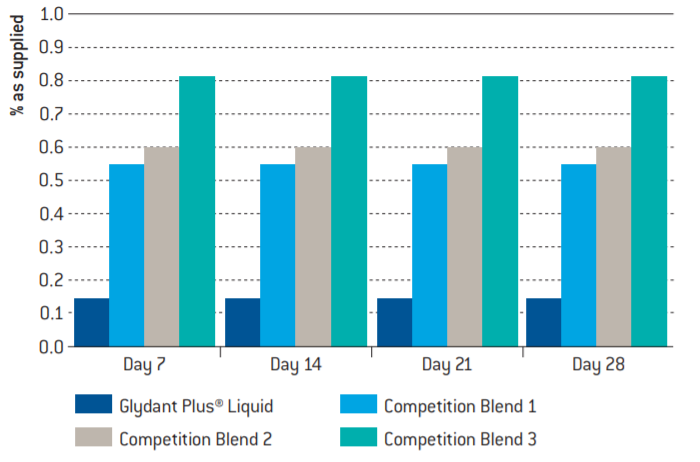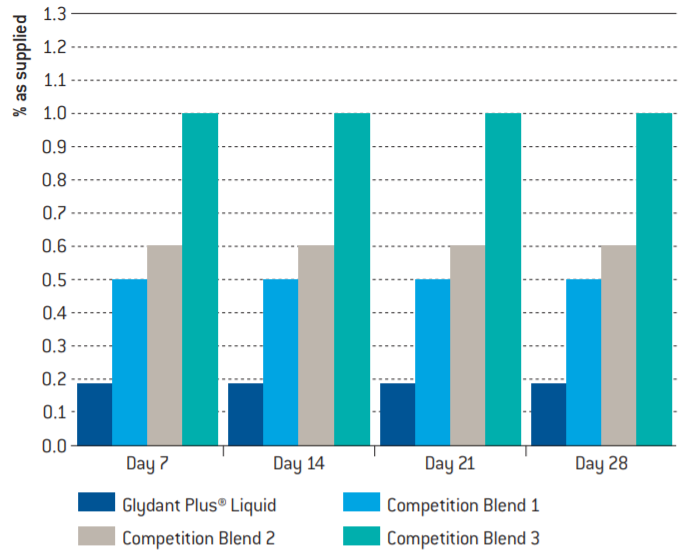Enhanced TDS
Knowde-enriched technical product data sheet
Identification & Functionality
- INCI Name
- Ingredient Origin
- Cosmetic Ingredients Functions
- Technologies
- Product Families
- Compositional Breakdown
Chemical Compound Breakdown Cas No. EINECS No. DMDM Hydantoin 6440-58-0 229-222-8 Butane-1,3-diol 107-88-0 203-529-7 3-iodo-2-propynyl butylcarbamate 55406-53-6 259-627-5 Water 7732-18-5 231-791-2 Chemical Compound Breakdown Percentage DMDMH range 64–72%* Butane-1,3-diol 5% min IPBC 2.2-2.8% Water 22.0–26.0 % *Note : This is the DMH + Formaldehyde solids content.
Glydant Plus® Liquid does not use the 2:1 ratio Formaldehyde to DMH.
Features & Benefits
- Benefit Claims
- Labeling Claims
- Key Attributes
- Highly cost-effective use level
- Stable in sunlight and over a wide range of temperatures and pH
- Low free formaldehyde and improved toxicology profile
- Compatible with virtually all raw materials used in personal care formulations
- Low odor
- Liquid product, water soluble
- Ease of use, no pre-mixing
- Patented blend of DMDMH and IPBC
- Synergistic, broad spectrum mode of action: no need for auxiliary preservatives
- Has a wide range of global regulatory acceptance
Applications & Uses
- Markets
- Applications
- Application Format
- AP/Deo Applications
- Baby Care Applications
- Bath & Shower Applications
- Color Cosmetic Applications
- Hair Care Applications
- Personal Hygiene Applications
- Skin Care Applications
- Sun Care Applications
- Wipes, Tissue & Towel Applications
- Use Level
- 0.15-0.36%
- Application pH Range
- 2–9
- Applications
- Anhydrous
- Baby care (rinse-off only)
- Body wash
- Conditioner
- Cream
- Deo / Anti-perspirant
- Eye creams/gels
- Eye shadow
- Face lotion
- Face wipes
- Facial cream
- Foundation
- Hair gel
- Hand soap
- Lotion
- Make up remover
- Mascara
- Oil in Water
- Powder
- Shampoo
- Suncare
- Toner
- Water in Oil
- Formulation Recommendations
- Can be added at both room and elevated temperatures as high as 60°C for 2–3 hours
- At high temperatures, mixing should be carried out in a closed vessel
- Wide pH range: 3–10
- Readily soluble in any aqueous phase, as well as in polar organic solvents like alcohols, glycols, glycol esters, alkyl sulfates, amphoterics, and alkanolamides
- Compatible with virtually all raw materials used in personal care formulations including anionic, cationic and nonionic surfactants, thickening agents, chelating agents, colors and fragrances
Properties
- Physical Form
- Soluble in
- Water
- Glydant Plus® Liquid Solubility & Compatibility Characteristics
General Class Specific Example Water Water Soluble Alcohols Ethanol Soluble Glycols Propylene Glycol Soluble Alkyl Sulfates Sodium Lauryl Sulfate Compatible Quaternized Compounds Dicetyl Dimethyl Ammonium Chloride Compatible Amphoterics Cocoamidopropyl Betaine Compatible Glycol Esters PEG-4 Laurate Compatible Alkanolamide Cocamide DEA Compatible
Regulatory & Compliance
- Certifications & Compliance
- Chemical Inventories
- Global Regulatory
Europe
- Both active ingredients approved, Annex V to Regulation EC/1223/2009.
- Finished products containing DMDMH must be labeled with the warning “contains formaldehyde” if the (free) formaldehyde concentration exceeds 0.05%
- Max use level: 0.6% DMDMH and 0.01% IPBC (leave-on except in creams and lotions aimed to be applied on a large part of the body), 0.6% DMDMH and 0.02% IPBC (rinse-off). Allowed in rinseoff products up to 0.02% IPBC and up to 0.01% IPBC
- Not allowed for oral and lip products
- Cannot be used in products for children under three years (except for rinse-off)
Japan
- Listed in the positive list. The following warning must be labeled: “should not be used by infants or by people who are hypersensitive to formaldehyde.”
- Cannot be used in leave-on due to DMDMH
- Max use level: 0.3% DMDMH and 0.02% IPBC for rinse-off
- Not permitted in oral care
USA
- Approved by CTFA for both rinse-off and leave-on applications
- Max use level of 0.6% DMDMH and 0.01% IPBC
General
- Not for use in oral and lip care
Technical Details & Test Data
- Efficacy
Microbiological Challenge Studies
Studies were run using different concentrations of Glydant Plus® Liquid in various formulations to see efficacy against various bacteria, yeast and fungi. All samples were inoculated at the beginning of the study, sampled at 24 hours, 3, 7, 14, 21 and 28 days.- GMS Cream
Ingredients(all unpreserved) % wt/wt Glyceryl monostearate 6.0% POE 20 glyceryl monostearate 4.0% Cetearyl alcohol 1.5% Myristyl propionate 8.0% Glycerin 5.0% Sterile DI water 75.5% Total 100% - Percentage of Glydant Plus® Liquid required to achieve <10 cfu/g of mix inocula in the GMS cream
Glydant Plus® Liquid Competitor A Competitor B Competitor C Competitor D Bacteria1 Day7 0.15 0.2 0.3 >0.6 >0.8 Day14 0.15 0.2 0.4 >0.6 <0.8 Day21 0.15 0.2 0.3 >0.6 <0.8 Day28 0.15 0.2 0.3 >0.6 <0.8 Fungi2 Day7 0.2 >0.8 >0.8 >0.6 >1.0 Day14 0.2 0.8 >0.8 >0.6 >0.8 Day21 0.2 0.8 >0.8 >0.6 >0.8 Day28 0.2 0.8 >0.8 >0.6 >0.8 1 Mix inoculum of bacteria consists of E.coli, P.aeruginosa and S.aureus.
2 Mix inoculum of fungi consists of C.albicans and A.niger.
NT = Not TestedCompetitor A: commercially available blend containing 60% Propylene Glycol + 39.6% Diazolidinyl Urea + 0.4% IPBC.
Competitor B: commercially available blend containing 56% Propylene Glycol + 30% Diazolidinyl Urea + 11% Methylparabens + 3% Propylparabens.
Competitor C: 0.4% Methylparabens + 0.2% Propylparabens.
Competitor D: commercially available blend containing 70% Phenoxyethanol + 15% Methylparabens + 5% Isopropylparabens + 5% Isobutylparabens + 5% Butylparabens.
- Shampoo Formulation
Ingredients % wt/wt Sodium lauryl ether sulfate 35.0% Triethanolamine laurylsulfate 25.0% Cocamide DEA 3.0% Anhydrous protein 1.0% Sterile DI water 36.0% Total 100.0% - Percentage of Glydant Plus® Liquid required to achieve <10 cfu/g of mix inocula in the Shampoo
Glydant Plus® Liquid Competitor C Competitor D Bacteria1 Day7 0.1 NT NT Day14 0.1 NT NT Day21 0.1 NT NT Day28 0.1 NT NT Fungi2 Day7 0.1 >0.6 >0.8 Day14 0.1 >0.6 >0.8 Day21 0.1 >0.6 >0.8 Day28 0.1 >0.6 >0.8 1 Mix inoculum of bacteria consists of E.coli, P.aeruginosa and S.aureus.
2 Mix inoculum of fungi consists of C.albicans and A.niger.
NT = Not TestedCompetitor A: commercially available blend containing 60% Propylene Glycol + 39.6% Diazolidinyl Urea + 0.4% IPBC.
Competitor B: commercially available blend containing 56% Propylene Glycol + 30% Diazolidinyl Urea + 11% Methylparabens + 3% Propylparabens.
Competitor C: 0.4% Methylparabens + 0.2% Propylparabens.
Competitor D: commercially available blend containing 70% Phenoxyethanol + 15% Methylparabens + 5% Isopropylparabens + 5% Isobutylparabens + 5% Butylparabens.
- Percentage of Glydant Plus® Liquid required to achieve <10 cfu/g of mixed bacteria* in a Non-ionic Cream

- Commercially available blend of 72% Phenoxyethanol + 17% Methylparabens
+ 2% Ethylparabens + 2% Propylparabens - Commercially available blend of 73% Benzyl alcohol + 18% Methylparabens + 9% Propylparabens
- Commercially available blend of 70% Phenoxyethanol + 15% Methylparabens
+ 5% Isopropylparabens + 5% Isobutylparabens + 5% Butylparabens
*P. aeruginosa ATCC #9027, S. aureus ATCC #6538, E. coli ATCC #8739
- Commercially available blend of 72% Phenoxyethanol + 17% Methylparabens
- Percentage of Glydant Plus® Liquid required to achieve <10 cfu/g of mixed fungi* in a Non-ionic Cream

- Commercially available blend of 72% Phenoxyethanol + 17% Methylparabens
+ 2% Ethylparabens + 2% Propylparabens - Commercially available blend of 73% Benzyl alcohol + 18% Methylparabens + 9% Propylparabens
- Commercially available blend of 70% Phenoxyethanol + 15% Methylparabens
+ 5% Isopropylparabens + 5% Isobutylparabens + 5% Butylparabens
*A. Niger ATCC #16404, C. albicans ATCC #10231
- Commercially available blend of 72% Phenoxyethanol + 17% Methylparabens
- Additional Information
% total HCHO % IPBC Time (months) 23°C 40°C 50°C 23°C 40°C 50°C 1 100 100 100 100 100 > 90 3 100 > 95 NT > 90 > 95 NT 12 > 95 NT NT > 95 NT NT 18 > 95 NT NT > 90 NT NT - Viscosity, pH, Color and Homogeneity
A stability study has been conducted by adding 0.3% Glydant Plus® Liquid in a broad variety of personal care products, and by checking viscosity, pH, color and homogeneity of the end products after one month at room temperature and 50°C. Glydant Plus® Liquid proved to be compatible with all of the tested products. No major change was observed for either criteria.
Water-white to light yellow color of Glydant Plus® Liquid is stable when stored at 23°C.
Glydant Plus® Liquid homogeneous phase is stable when stored at 23°C. After storage of three months at 40°C, one month at 50°C and three months exposure to sunlight, Glydant Plus® Liquid maintains its homogeneity.
- Typical % Free HCHO level
% Free HCHO Glydant Plus® Liquid < 0.1% Competitor A > 1.0% Competitor B > 1.0%
Packaging & Availability
- Country Availability
- Regional Availability

